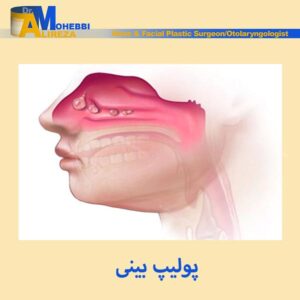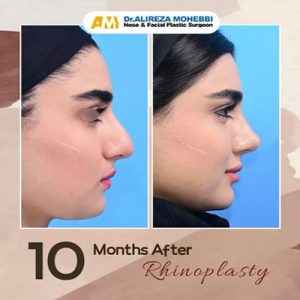F. Pourdanesh, R. Sharifi, A. Mohebbi, A. JamilianInt. J. Oral Maxillofac. Surg 2012;xxx: xxx–xxx. # 2012 International Association of Oral and Maxillofacial Surgeons.
Different movements of the maxilla in Le Fort I osteotomies have distinct effects on the nasal morphology. Kunkel and Hoch-ban were the first to describe the effect of maxillary movement on nasal volume assessed by acoustic rhinometry.1
Turvey et al. found that superior repositioning of the maxilla, with or without involvement of the nasal floor, usually results in decreased nasal resistance.2
Erbe et al.found no nasal airway changes after Le Fort I impaction or advancement.3
Spald-ing et al. reported that no prediction could be made for any patient regarding the effect of maxillary surgery on nasal function parameters and there was no consis-tent association between the amount or direction of maxillary surgical movement or the position of the maxilla and nasal respiration.4
These contradictory results might be due to different types of Le Fort I osteotomy and whether the patient had alar base cinch suture. The contradictory results in the literature encouraged the authors to carry out new research. The purpose of this study is to evaluate nasal airflow and resistance after maxillary impaction, maxillary advancement, or a combination of both. The investigators hypothesized that improvements might be seen after Le Fort I osteotomy with alar base cinch suture. The specific aims of the study are to evaluate nasal airflow, nasal resistance and the patient’s nasal volume before and after Le Fort I osteotomy.
Materials and methods
The investigators designed and imple-mented a clinical prospective study com-posed of patients who were referred to the Oromaxillofacial Department for Le Fort I surgery. All participants signed an informed consent agreement. To be included in the study sample, the patients had to have dentofacial deformity which required Le Fort I osteotomy for correc- tion. Patients were excluded as study sub- jects if they had sinusitis, allergic rhinitis, adenoid hyperplasia, craniofacial syndromes, segmental Le Fort I, previous trauma and surgery, especially rhino- plasty.
The patients were separated into 3 sur-gical groups depending on the type of orthognathic surgery they had received, including maxillary impaction (Group1), maxillary advancement(Group 2) or a combination of both (Group 3). All the patients underwent conventional Le Fort Iosteotomy with alar base cinch suture.
The research began 1 week before sur-gery when the patients filled out a ques-tionnaire and underwent rhinological examination, anterior rhinomanometry and acoustic rhinometry. The examina-tions were repeated by the same otorhino-laryngologist 3 months after surgery.
Examinations carried out included doc-umentation of luxations, presence of sep-tal deviations, perforations, spurs,mucosal changes and enlarged turbinates (Table 1).
Uninasal anterior active mask rhinomanometry was performed using a NR6 rhinomanometer (GM Instruments Ashgrove, Kilwinning, UK) to assess the nasal airflow and airway resistance of each patient.1
In rhinomanometry, total nasal flow and total nasal resistance were mea-sured. Acoustic rhinometry, described by Jackson et al.,5 was used to evaluate total nasal volume, crossectional areas of nos-trils at the isthmus nasi (IN) and head of the inferior concha in cm.2 An A1 acoustic rhinometer (GM Instruments Ashgrove, Kilwinning, UK) was used for evaluations before and after surgery.
5 randomly selected patients were re-evaluated to determine the level of error in the measurements. There was no signifi- cant difference between the measure-ments. Wilcoxon matched-pairs signed rank test was used for pre- and postopera-tive findings. The x2 test was used for intergroup evaluations. The data were ana- lyzed using the Statistical Package for the Social Sciences (version 18, SPSS, Chi- cago, IL, USA).
Results
25 patients (6 males, 19 females) with a mean age of 22.4 3.32 years were eval-uated. The patients were separated into 3 surgical groups based on the type of orthognathic surgery they had received.Group 1 comprised 11 patients who needed maxillary impaction.
Group 2 included 9 patients who underwent maxillary advancement. Group 3 was composed of 5 patients undergoing both maxillary impaction and advancement. The amount of maxillary movement in each of the groups is shown in Table 2 All the patients underwent conventional Le Fort I osteotomy with alar base cinch suture.
Table 1 shows the pre- and postoperative findings of anterior rhinoscopy. Table 3 shows the rhinomanometric measurements of nasal airflow and nasal resistance. Total nasal airflow increased from 406 202 to 543 268 ml/s (P < 0.0005) and total nasal resistance decreased from 0.62 0.78 to 0.41 0.4 ml/s (P < 0.0005). Tables 4 and 5 show the acoustic rhinometry mea- surements for the total nasal volume and crosssectional areas at the IN and concha inferior before and after surgery. Total nasal volume decreased from 7.8 1.3 to 7.3 1.5 cm3 (P < 0.001). The total crosssection of the IN increased signifi- cantly from 0.49 0.1 to 0.52 0.1 cm2 ; while, the total crosssection of the concha inferior showed no significant changes.





Discussion
Nasal airflow and resistance changes were evaluated after Le Fort I osteotomy. It was hypothesized that they might improvement after Le Fort I osteotomy with alar base cinch suture. The rhinoscopic, rhinomanometric, and acoustic rhinometric measurements show that the total nasal function of all patients in the three groups improved significantly after Le Fort I surgery regardless of the direction of surgery.
Nasal airflow showed a significant increase in all groups; while nasal resistance showed a significant reduction (Table 3). These results contradict the results found by Erbe et al. who found no significant changes in total nasal airflow or nasal resistance in any patients.3
Acoustic rhinometry revealed that total nasal volume decreased in all patients. This decrease was significant in Groups 1 and 3, but was non-significant in Group 2 patients. The crosssectional area at the IN showed a significant increase in Groups 1 and 2 and totally, but no significant changes in Group 3. The cross-sectional area at the concha inferior showed no significant changes in any of the groups or totally.
Rhinomanometry and acoustic rhinometry are reliable and objective methods of determining functional and geometric changes in the nasal cavity after Le Fort Iosteotomy.6,7 The findings of this study corroborate previous studies suggesting that maxillary repositioning opens internal nose dimensions, thus improving nasal air flow and reducing nasal resistance. 2,4,8-11
Maxillary advancement tends to increase the nasolabial angle and thus to increase the vertical axis of the valve area. This results in a more favourable inflow of air into the nasal cavity and respiratory resistance. Enlarged turbinates and bony spurs can cause a decrease in airflow through the nose, so their reduction will result in an increase in nasal volume. The resulting increase in nasal volume plays a favourable role in decreasing airway resis- tance and increasing airway flow. An increase in the width of the alar base is commonly observed especially after maxillary impaction surgery. Supplementary surgical procedures, such as an alar cinch, may also improve nasal breathing by changing the external nares from narrow slits to more ovoid forms postoperatively. 12 The authors presume that their findings regarding improvement of airflow differ from those of Erbe et al. because of the cinch procedure in the alar base. The results give the authors an opportunity for correlative clinical studies. This study has some limitations such as the small sample size. The effects of maxillary setback on nasal airflow can be studied in future research.
In conclusion, up to 5.5 mm of maxillary impaction, advancement or a combination of both as a result of Le Fort I surgery combined with cinched procedure in the alar base will reduce total nasal resistance and thus improve total nasal airflow. Patients undergoing Le Fort I osteotomy should be advised about possible improvements in their nasal airflow especially if the impaction is less than 5.5 mm.
Funding
This research was supported by Head and Neck Research Center of Rasoul Akram Medical Complex, TUMS.
Competing interests
None declared.
Ethical approval
All the patients signed informed consent form before their surgery. It was done as the normal procedure of the hospital where the surgeries were done.
References
- Kunkel M, Hochban W. The influence of maxillary osteotomy on nasal airway patency and geometry. Mund Kiefer Gesichtschir 1997;1:194–8.
- Turvey TA, Hall DJ, Warren DW. Alterations in nasal airway resistance following superior repositioning of the maxilla. Am J Orthod 1984;85:109–14.
- Erbe M, Lehotay M, Gode U, Wigand ME, Neukam FW. Nasal airway changes after Le Fort I—impaction and advancement: anatomical and functional findings. Int J Oral Maxillofac Surg 2001;30:123–9.
- Spalding PM, Vig PS, Lints RR, Vig KD,Fonseca RJ. The effects of maxillary surgery on nasal respiration. Int J Adult Orthodon Orthognath Surg 1991;6:191–9.
- Jackson AC, Butler JP, Millet EJ, Hoppin Jr FG, Dawson SV. Airway geometry by analysis of acoustic pulse response measurements. J Appl Physiol 1977;43:523-36.
- Cakmak O, Coskun M, Celik H, Buyuklu F,Ozluoglu LN. Value of acoustic rhinometry for measuring nasal valve area. Laryngoscope 2003;113:295–302.
- Numminen J, Dastidar P, Heinonen T, Kar-huketo T, Rautiainen M. Reliability of acoustic rhinometry. Respir Med 2003;97:421–7.
- Gotzfried HF, Masing H. On the improvement of nasal breathing following mid-face osteotomies, and possible reasons for the phenomenon. J Maxillofac Surg 1984;12: 29–32.
- Guenthner TA, Sather AH, Kern EB. The effect of Le Fort I maxillary impaction on nasal airway resistance. Am J Orthod 1984;85:308–15.
- Stoker NG, Epker BN. The posterior maxillary ostectomy: a retrospective study of treatment results. Int J Oral Surg 1974;3:153–7.
- Timms DJ. Re: The effect of Le Fort I maxillary impaction on nasal airway resis-tance. Am J Orthod 1984;86:439.
- Haarmann S, Budihardja AS, Wolff KD,Wangerin K. Changes in acoustic airway profiles and nasal airway resistance after Le Fort I osteotomy and functional rhino- surgery: a prospective study. Int J Oral Maxillofac Surg 2009;38:321–5.





